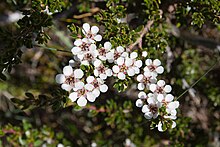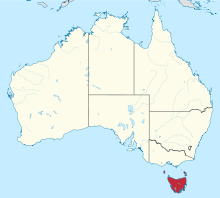| Leptospermum rupestre | |
|---|---|

| |
| Leptospermum rupestre, Walls of Jerusalem National Park | |
|
Scientific classification
| |
| Kingdom: | Plantae |
| Clade: | Tracheophytes |
| Clade: | Angiosperms |
| Clade: | Eudicots |
| Clade: | Rosids |
| Order: | Myrtales |
| Family: | Myrtaceae |
| Genus: | Leptospermum |
| Species: | L. rupestre
|
| Binomial name | |
| Leptospermum rupestre | |

| |
| Leptospermum rupestre is endemic to Tasmania [2] | |
| Synonyms [2] | |
Leptospermum rupestre, commonly known as alpine tea-tree or prostrate tea-tree, [3] is a flowering shrub in the myrtle family, Myrtaceae. It is endemic to Tasmania. In alpine areas it assumes a prostrate habit while in subalpine areas it appears as a large shrub.
Description
Leptospermum rupestre is a common alpine and subalpine shrub in Tasmania. The growth habit varies, at higher exposed altitudes it is a prostrate plant up to 1 m (3 ft 3 in) high. At lower altitudes it can become a large shrub to 4 m (13 ft) high. It has small, blunt, shiny dark green, oval to elliptic shaped leaves, 2–9 mm (0.079–0.354 in) long. The white flowers are small 1 cm (0.39 in) wide, 5 petalled, with an open habit and flower in profusion in leaf axils during summer. The reddish branches become mat-forming over rocks. The small seed capsules are about 5 mm (0.20 in) in diameter. [4] [5] [6]
Taxonomy and naming
Leptospermum rupestre was first formally described in 1840 by botanist Joseph Dalton Hooker and the description was published in Icones Plantarum. [7] [8] Robert Brown observed it growing on rocky outcrops on Mount Wellington and nearby mountains. The word rupestre is derived from the Latin word rupestris, [9] meaning rocky, referring to the habitat where it was found. [7]
Distribution and habitat
This species is endemic to Tasmania, found growing in a sunny situation on light to medium soils. [3]
Cultivation
It is one of the hardiest species of its genus and is suitable for cultivation outdoors. [10]
References
- ^ "Leptospermum rupestre". Australian Plant Census. Retrieved 9 November 2019.
- ^ a b "Leptospermum rupestre Hook.f." Plants of the World Online. Royal Botanic Gardens, Kew. Retrieved 4 January 2024.
- ^ a b "Leptospermum rupestre". Ole Lantana's Seed Store. Retrieved 20 December 2019.
- ^ Wrigley, John W.; Fagg, Murray (2001). Australian Native Plants. Louise Eggerton-Read New Holland. ISBN 1-876334-30-4.
- ^ "Leptospermum rupestre". Australian Native Plants-Online. Retrieved 19 December 2019.
- ^ "Leptospermum rupestre (Myrtaceae)". Key to Tasmanian vascular plants. University of Tasmania. Retrieved 10 January 2012.
- ^ a b "Icones Plantarum". Biodiversity Heritage Library. Retrieved 18 December 2019.
- ^ "Leptospermum rupestre". Australian Plant Name Index. Retrieved 19 December 2019.
- ^ Francis Aubie Sharr (2019). Western Australian Plant Names and their Meanings. Kardinya Western Australia: Four Gables Press. p. 299. ISBN 9780958034180.
- ^ Dawson, M. (2012). "Australian Leptospermum in cultivation: species and cultivars." NZ Garden J, 15, 14-22.